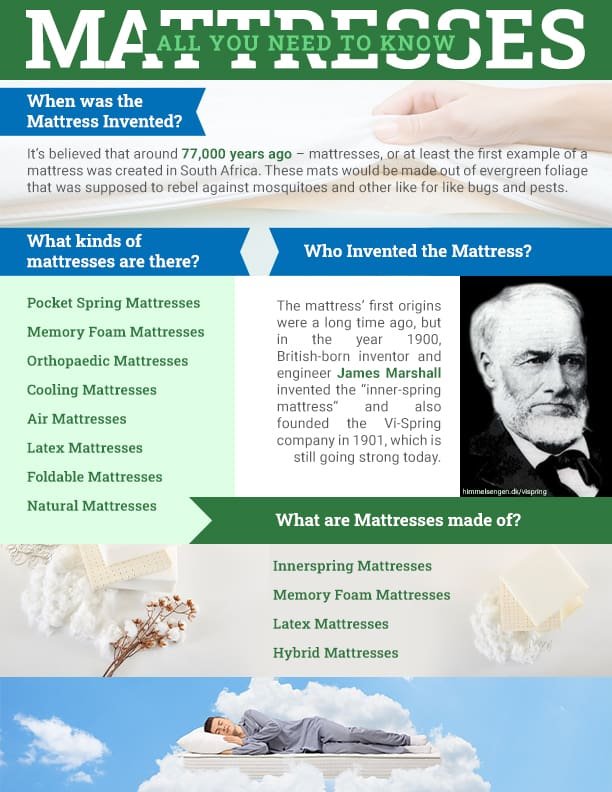When was the Mattress Invented? All you need to know
We all take it for granted, but our mattress is usually our best friend when it comes to the perfect night’s sleep; but what are we sleeping on? Who thought of it? Where did it all start? In today’s blog post, we look at all you need to know about the history of the mattress and where modern technology has taken it today.
What is a Mattress
A mattress is a large, rectangular fabric body filled with various materials, most commonly soft, firm or springy fillings that provide muscle support and comfortable sleeping options when you sleep.
When was the Mattress Invented
It’s believed that around 77,000 years ago – mattresses, or at least the first example of a mattress, were created in South Africa. These mats would be made of evergreen foliage that would rebel against mosquitoes and other like-for-like bugs and pests.
It’s believed that these mattresses were made about 1-2 feet thick and 22 feet long, about the same size as your local lamp posts. These were probably uncomfortable but offered more support and improved comfortability than sleeping on cold, hard ground. These cave findings of the mattress were the start of the mattress revolution, but it wouldn’t be till the mid-18th century that the appearance of the coil spring was invented and modernized into a design that is still used today.
Who Invented the Mattress
The mattress’ first origins were a long time ago. Still, in 1900, British-born inventor and engineer James Marshall invented the “innerspring mattress” and founded the Vi-Spring company in 1901, which is still strong today. However, in the 18th century, German engineer and innovator Heinrich Westphal invented and patented the first innerspring mattress in 1871. It’s believed that since their conception 77,000 years ago, these two inventors have modernized and driven mattress technology forward.
8 Mattress Types – Most Popular
With modern design and technology that stems much further than just mattresses, there are now many different types of mattresses, but they can be categorized into a few main categories. They are as follows;
- Pocket Spring Mattresses – A mattress with small steel coils in individual pockets provides a springy yet either firm or soft based on requirements.
- Memory Foam Mattresses – A memory foam mattress is a mattress that contains a firm but very spongy material that sits atop more foam or springs that offer a supportive yet comfortable base for sleep.
- Orthopaedic Mattresses – An orthopaedic mattress is designed to support people with spine or back-related issues. These mattresses are often firm yet comfortable surfaces; however, they target the back specifically for a better night’s sleep for those suffering from spine or joint issues.
- Cooling Mattresses – A cooling mattress is similar to a memory foam mattress. Still, it is often created using specialized gels, silicon, and foams that draw the heat away from your body, resulting in a cooler night’s sleep.
- Air Mattresses – Air mattresses are often made from latex or other plastic textiles that can be filled with air to inflate a quick yet comfortable, sturdy mattress.
- Latex Mattresses – A latex mattress combines different foams, such as memory foam or springs, to support a comfortable but extremely soft mattress.
- Foldable Mattresses – A foldable mattress is like your regular mattress; however, it is in several segments that can be folded away for tight spaces or taken away with you. The quality of these mattresses may not be top-tier, but they still offer many advantages.
- Natural Mattresses – A natural mattress is made with no synthetic fabrics. Natural fillings, such as cotton, wool, and sometimes even bamboo, are used.
These mattresses are supported by years of research, modern technological advancements and even multiple companies offering trials and support options. If you can think of a mattress type or a specific feature you want from your mattress, you’ll find it from one company.

What Are Mattresses Made Of
Mattresses, depending on the brand, are made from many different materials. We’ve tried categorizing it into a few categories to give you the best overview of the mattress you could buy.
- Innerspring Mattresses – Innerspring mattresses are designed using the traditional springs. These steel coils are individually coiled and positioned for maximum comfort. These mattresses typically house anywhere from 500 to 2,000 springs, and different materials accommodate this. This includes canvas, cotton, wool and other felt-like textiles that usually branch from cotton.
- Memory Foam Mattresses – Memory foam, or at least the foam part, is made from polyurethane foam manufactured in the 1950s by mixing halocarbons, hydrocarbons, and water. Many modern-day memory foam mattresses are made from polyol, water, and isocyanate, giving you super soft comfort. With several chemicals added, they can be made into other items from car parts, too, and of course, super comfortable mattresses.
- Latex Mattresses – Most latex mattresses are made from natural rubber in trees, specifically Hevea-Brasiliensis or Radium Natural Talalay. These combinations of tree milk, along with more chemicals, can be formed into synthetic c rubber and finally into a mattress. What is different about latex mattresses is that they hug you tightly, can be a great way to relieve aches and pains, and are ideal for people with chronic back issues.
- Hybrid Mattresses – As you can probably tell, hybrid mattresses are the best of both worlds. They contain roughly 1-3 inches of foam – such as the above memory foam mattresses but have approximately 15 inches of springs and other felt-cotton materials. Many people love hybrid mattresses for their springiness and comfortability, with many people referring to these kinds of mattresses as “a mattress with topper included.
Overall, we all take mattresses for granted, and losing our mattress for a few nights could be a real-life nightmare. We hope this blog post has explained all you need to know about the history of the mattress and what types you can buy, thanks to modern technology.



